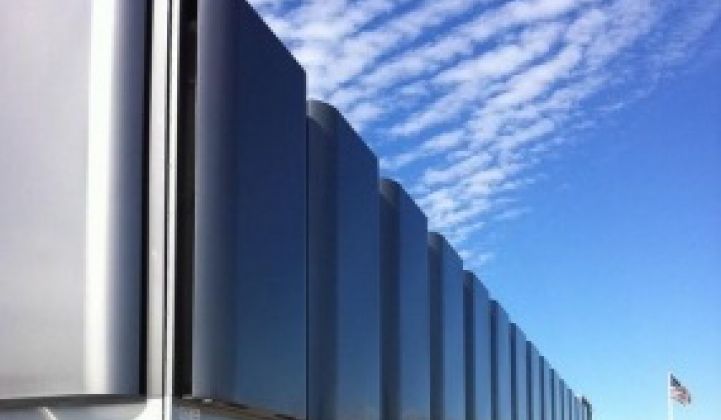Delaware politicians and regulators wanted Bloom Energy to build fuel cells in their home state -- so they established a consumer-borne subsidy package to ease Bloom's factory relocation. The fruits of that plan recently began to roll off the factory floor in Newark, Delaware as 50 employees began shipping "Bloom Boxes" to two substation sites in Delmarva Power's utility territory.
Bloom's fuel cells produce electrical power from natural gas via an electrochemical reaction rather than burning the gas.
The factory, on the grounds of an old Chrysler assembly plant now owned by the University of Delaware, is not yet finished, according to Delaware Online -- but Delaware-assembled fuel cells units have already been placed into service.
According to reports, "The average residential Delmarva customer is expected to pay $2.07 in July in surcharges agreed to by the state as part of the subsidy package developed for the Bloom project in 2011." State legislators also allowed fuel cells to be considered as part of the utility's renewable energy portfolio requirements, an arguable classification.
In June of last year, GTM's Jeff St. John reported that Bloom's 30-megawatt project faced a lawsuit seeking to undo the project's financial underpinnings, on the grounds that it represents a “crony” deal that would unfairly charge utility ratepayers millions of dollars and bar competitors from the state. The lawsuit, filed in federal District Court in Delaware, accused Delaware governor Jack Markell and the Delaware Public Service Commission of “unconstitutionally discriminating against Bloom’s competitors and taxing a segment of Delaware residents to subsidize the crony company." Here's the complaint (PDF) on the suit.
St. John reported that Delmarva plans to raise more than $100 million over twenty years to help finance the project, which equates to a $1.34-per-month surcharge on customer bills. Delaware is also providing $18 million in state incentives, and the project is seeking a federal cash grant for renewable power projects. The total cost to Delmarva ratepayers is expected to be about $133 million.
Bloom builds fuel cells of the solid-oxide variety with natural gas as the fuel. There is no heat resource in the Bloom Box as in other CHP fuel cells.The 200-kilowatt units are intended for commercial and industrial applications, and the firm boasts an all-star list of customers, including Adobe, FedEx, Staples, Google, Coca-Cola, Wal-Mart and Apple, which is tapping Bloom for 4.8 megawatts of fuel cells.
Bloom has raised almost $1 billion in venture capital over a decade from investors including GSV Capital, Apex Venture Partners, DAG Ventures, Kleiner Perkins Caufield & Byers, Mobius Venture Capital, Madrone Capital, New Enterprise Associates, SunBridge Partners, Advanced Equities, and Goldman Sachs.
Bloom Energy has suggested that it will turn a profit in 2013. Scott Sandell, a partner at NEA and Bloom board member, was quoted by Reuters as saying that Bloom will likely attempt an IPO late this year or early next. Sandell is/was a board member of SolFocus, Fisker Automotive and HelioVolt.
According to an investor letter cited by Dan Primack of Fortune, Bloom had $101 million in pro forma Q3 2012 revenue, while cost of goods was $106 million, along with $26 million in operating expenses. That's a loss of $42 million on a GAAP basis, along with a net cash loss of $80 million in the quarter. However, those Q3 numbers are hobbled by an inventory and timing issue, and cash burn dropped 56 percent between Q2 and Q3, according to Primack. The firm had a 26 percent quarter-over-quarter revenue increase. But its first quarter of 2013 held less encouraging revenue news.
Bloom's fuel -- natural gas -- is a commodity and subject to price increases. Bloom's business has relied on state subsidies for distributed energy, but subsidies expire. The long-term reliability of the fuel cell stack remains a risk, and some have doubted Bloom's green claims and employment practices.
But in today's difficult cleantech business climate, those profit noises from the CFO are cause for cautious optimism. If Bloom is actually profitable in 2013 or 2014, the company would be a testament to the viability of capital-intensive, VC-funded cleaner energy breakthroughs and the virtue of distributed power generation. If not -- Kleiner Perkins, NEA, K.R. Sridhar, Scott Sandell and a number of other VCs will have some explaining to do to their limited partners.
Bloom's website claims that its fuel cells "will decrease carbon dioxide emissions by approximately 50 percent compared to Delaware's electric grid, nearly eliminate smog-forming particulate emissions such as SOx and NOx, and use less than 0.002% of the water required by conventional electricity generation."
Josh Richman, Bloom VP, was quoted as saying, "We’re growing and hiring," adding that the factory was now meeting only orders for Delmarva. Company representatives have mentioned a potential 900 manufacturing jobs in the Newark, Delaware area when the factory is running at capacity.
Asim Hussain, Bloom's person in charge of not responding to reasonable inquiries from the press, did not respond to inquiries on subsidies, employee ramp, or the manufacturing steps performed at the Delaware factory.



